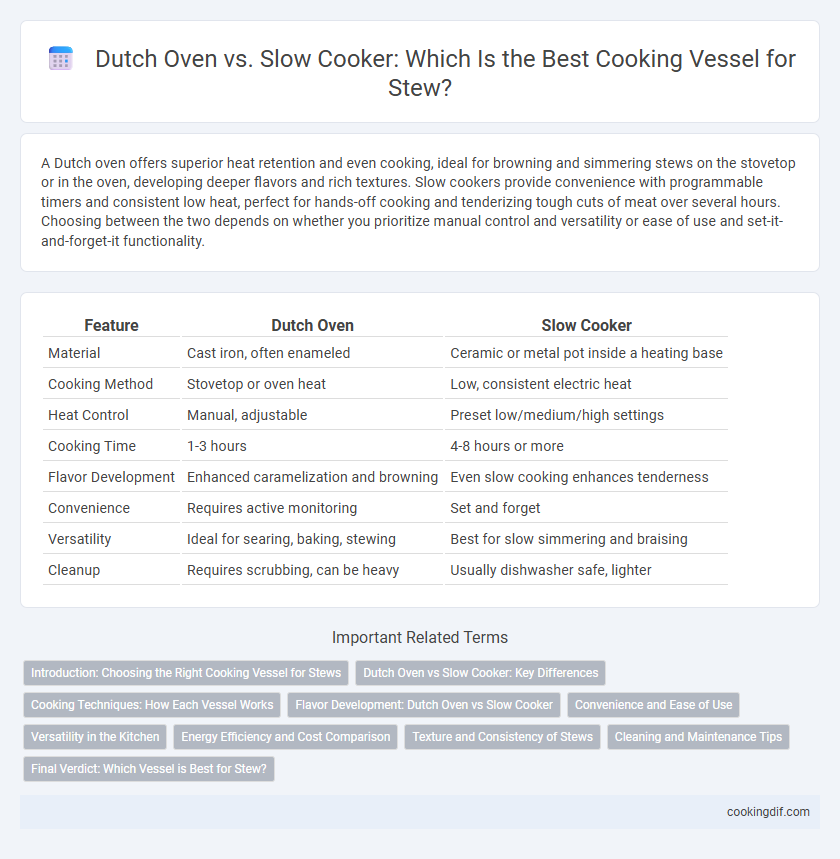A Dutch oven offers superior heat retention and even cooking, ideal for browning and simmering stews on the stovetop or in the oven, developing deeper flavors and rich textures. Slow cookers provide convenience with programmable timers and consistent low heat, perfect for hands-off cooking and tenderizing tough cuts of meat over several hours. Choosing between the two depends on whether you prioritize manual control and versatility or ease of use and set-it-and-forget-it functionality.
Table of Comparison
| Feature | Dutch Oven | Slow Cooker |
|---|---|---|
| Material | Cast iron, often enameled | Ceramic or metal pot inside a heating base |
| Cooking Method | Stovetop or oven heat | Low, consistent electric heat |
| Heat Control | Manual, adjustable | Preset low/medium/high settings |
| Cooking Time | 1-3 hours | 4-8 hours or more |
| Flavor Development | Enhanced caramelization and browning | Even slow cooking enhances tenderness |
| Convenience | Requires active monitoring | Set and forget |
| Versatility | Ideal for searing, baking, stewing | Best for slow simmering and braising |
| Cleanup | Requires scrubbing, can be heavy | Usually dishwasher safe, lighter |
Introduction: Choosing the Right Cooking Vessel for Stews
Selecting the ideal cooking vessel for stews involves evaluating factors such as heat distribution, cooking time, and flavor development. Dutch ovens provide superior heat retention and even cooking through cast iron, enhancing the richness and depth of stews. Slow cookers offer convenience with programmable settings and low-temperature simmering, creating tender dishes with minimal effort.
Dutch Oven vs Slow Cooker: Key Differences
Dutch ovens provide superior heat retention and even cooking due to their heavy cast iron construction, making them ideal for stovetop-to-oven stewing with rich, deep flavors. Slow cookers offer convenience with programmable timers and consistent low temperatures, perfect for unattended long-cooking meals but may result in less caramelization compared to a Dutch oven. The Dutch oven excels in versatility and browning techniques, while slow cookers prioritize ease and hands-off cooking for tender, slow-simmered stews.
Cooking Techniques: How Each Vessel Works
A Dutch oven uses direct heat from a stovetop or oven, providing consistent, high-temperature cooking that allows for browning and caramelization, essential for developing rich flavors in stew. Slow cookers operate at lower, steady temperatures over extended periods, utilizing moist heat to break down tough cuts of meat gradually, resulting in tender and flavorful dishes. The Dutch oven's versatility supports sauteing and searing before slow simmering, while slow cookers offer convenience through hands-off, all-day cooking.
Flavor Development: Dutch Oven vs Slow Cooker
A Dutch Oven excels in flavor development due to its ability to maintain high, consistent heat, allowing Maillard reactions and caramelization that enhance the stew's depth and complexity. Slow Cookers operate at lower temperatures, which gently meld flavors over time but may lack the rich, browned notes produced by a Dutch Oven. For stews requiring robust, layered flavors, the Dutch Oven is often the superior choice.
Convenience and Ease of Use
A Dutch oven offers versatility with stovetop and oven use, enabling searing and slow cooking in one pot, but it requires monitoring and manual temperature control. Slow cookers provide effortless set-and-forget convenience with programmable timers and consistent low-heat cooking, ideal for busy schedules or hands-off meals. Both vessels retain moisture effectively, yet slow cookers excel in ease of use due to their automatic temperature regulation and minimal supervision.
Versatility in the Kitchen
A Dutch oven offers exceptional versatility with its ability to seamlessly transition from stovetop searing to oven braising, making it ideal for a wide range of stew recipes. Slow cookers excel in convenience by allowing long, low-temperature cooking without constant supervision, perfect for hands-off meal preparation. Choosing between the two depends on whether you prioritize multi-functional cooking techniques or unattended, time-saving convenience in your kitchen.
Energy Efficiency and Cost Comparison
Dutch ovens, typically made from cast iron, retain and distribute heat efficiently, allowing for cooking with lower energy after initial heating on the stovetop or oven, which can reduce overall energy usage. Slow cookers use low wattage over extended periods, consuming less electricity compared to oven heating but potentially increasing energy costs due to longer cook times. In terms of cost, Dutch ovens have a higher upfront price but offer durability and versatility, while slow cookers are generally cheaper initially but may incur higher energy expenses with frequent use.
Texture and Consistency of Stews
Dutch ovens excel in producing stews with rich, deep flavors and a thick, hearty texture due to their ability to maintain even heat and allow liquid evaporation. Slow cookers create consistently tender meat but often result in a thinner broth because of the sealed cooking environment that traps moisture. The choice between Dutch oven and slow cooker significantly impacts stew consistency, with Dutch ovens enhancing caramelization and slow cookers preserving a gentle simmer for uniform tenderness.
Cleaning and Maintenance Tips
Dutch ovens, typically cast iron, require seasoning to maintain their non-stick surface and prevent rust, demanding hand washing without soap to preserve the seasoning layer. Slow cookers feature ceramic or porcelain inserts that are dishwasher safe, offering easier cleaning though they may chip or crack if handled roughly. Regularly checking for cracks in slow cooker inserts and re-seasoning cast iron Dutch ovens ensure their longevity and optimal cooking performance.
Final Verdict: Which Vessel is Best for Stew?
The Dutch oven offers superior heat retention and the ability to develop rich, caramelized flavors due to its oven-safe design and thick cast iron construction, making it ideal for stews that require high-temperature browning and slow, even cooking. The slow cooker excels in convenience and consistent low heat, perfect for hands-off cooking and tenderizing tougher cuts of meat over several hours without constant monitoring. For rich, deeply flavored stews with complex textures, the Dutch oven remains the preferred cooking vessel, while the slow cooker is best suited for easy, set-it-and-forget-it meals.
Dutch Oven vs Slow Cooker for Cooking Vessel Infographic

 cookingdif.com
cookingdif.com